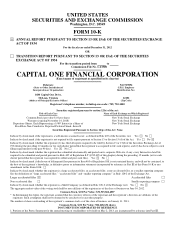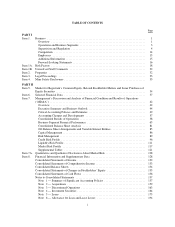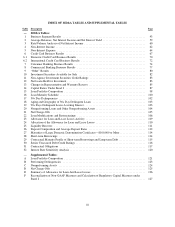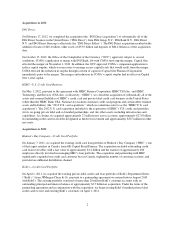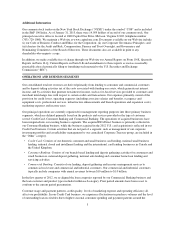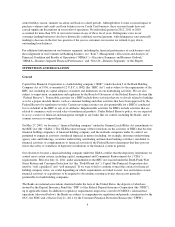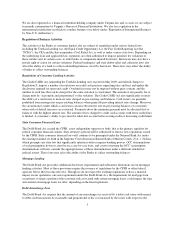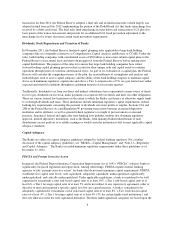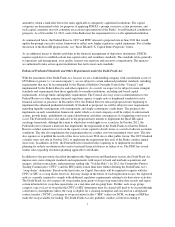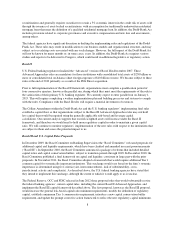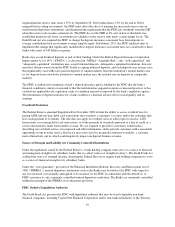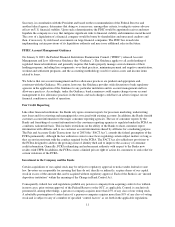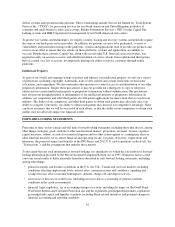Capital One 2012 Annual Report Download - page 25
Download and view the complete annual report
Please find page 25 of the 2012 Capital One annual report below. You can navigate through the pages in the report by either clicking on the pages listed below, or by using the keyword search tool below to find specific information within the annual report.transaction. In June 2011, the Federal Reserve adopted a final rule and an interim final rule (which largely was
adopted in final form in July 2012) implementing the portion of the Dodd-Frank Act that limits interchange fees
received by a debit card issuer. The final rules limit interchange fees per debit card transaction to $.21 plus five
basis points of the transaction amount and provide for an additional $.01 fraud prevention adjustment to the
interchange fee for issuers that meet certain fraud prevention requirements.
Dividends, Stock Repurchases and Transfers of Funds
In November 2011, the Federal Reserve finalized capital planning rules applicable to large bank holding
companies like us (commonly referred to as Comprehensive Capital Analysis and Review or CCAR). Under the
rules, bank holding companies with consolidated assets of $50 billion or more must submit capital plans to the
Federal Reserve on an annual basis and must obtain approval from the Federal Reserve before making most
capital distributions. The purpose of the rules is to ensure that large bank holding companies have robust,
forward-looking capital planning processes that account for their unique risks and capital needs to continue
operations through times of economic and financial stress. As part of its evaluation of a capital plan, the Federal
Reserve will consider the comprehensiveness of the plan, the reasonableness of assumptions and analysis and
methodologies used to assess capital adequacy and the ability of the bank holding company to maintain capital
above each minimum regulatory capital ratio and above a Tier 1 common ratio of 5% on a pro forma basis under
expected and stressful conditions throughout a planning horizon of at least nine quarters.
Traditionally, dividends to us from our direct and indirect subsidiaries have represented a major source of funds
for us to pay dividends on our stock, make payments on corporate debt securities and meet our other obligations.
There are various federal law limitations on the extent to which the Banks can finance or otherwise supply funds
to us through dividends and loans. These limitations include minimum regulatory capital requirements, federal
banking law requirements concerning the payment of dividends out of net profits or surplus, Sections 23A and
23B of the Federal Reserve Act and Regulation W governing transactions between an insured depository
institution and its affiliates, as well as general federal regulatory oversight to prevent unsafe or unsound
practices. In general, federal and applicable state banking laws prohibit, without first obtaining regulatory
approval, insured depository institutions, such as the Banks, from making dividend distributions if such
distributions are not paid out of available earnings or would cause the institution to fail to meet applicable capital
adequacy standards.
Capital Adequacy
The Banks are subject to capital adequacy guidelines adopted by federal banking regulators. For a further
discussion of the capital adequacy guidelines, see “MD&A—Capital Management” and “Note 13—Regulatory
and Capital Adequacy.” The Banks exceeded minimum regulatory requirements under these guidelines as of
December 31, 2012.
FDICIA and Prompt Corrective Action
In general, the Federal Deposit Insurance Corporation Improvement Act of 1991 (“FDICIA”) subjects banks to
significantly increased regulation and supervision. Among other things, FDICIA requires federal banking
agencies to take “prompt corrective action” for banks that do not meet minimum capital requirements. FDICIA
establishes five capital ratio levels: well capitalized; adequately capitalized; undercapitalized; significantly
undercapitalized; and critically undercapitalized. Under applicable regulations, a bank is considered to be well
capitalized if it maintains a total risk-based capital ratio of at least 10%, a Tier 1 risk-based capital ratio of at
least 6%, a Tier 1 leverage capital ratio of at least 5% and is not subject to any supervisory agreement, order or
directive to meet and maintain a specific capital level for any capital measure. A bank is considered to be
adequately capitalized if it maintains a total risk-based capital ratio of at least 8%, a Tier 1 risk-based capital
ratio of at least 4%, a Tier 1 leverage capital ratio of at least 4% (3% for certain highly rated institutions), and
does not otherwise meet the well capitalized definition. The three undercapitalized categories are based upon the
6



